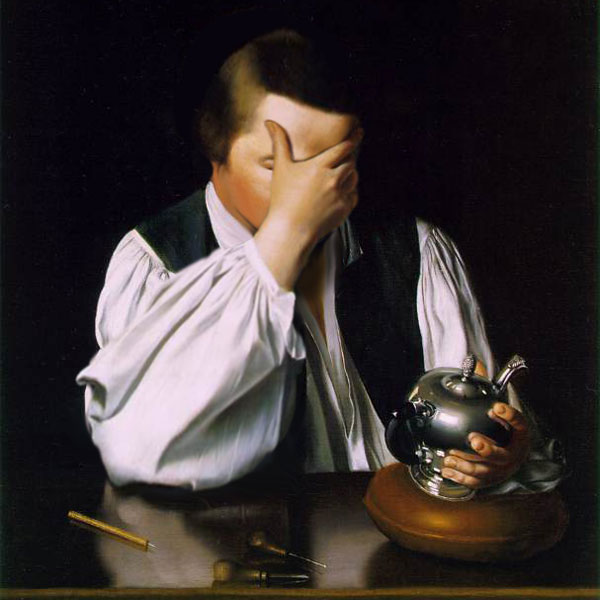The Latest from Boing Boing |  |
- Kickstarter project: flatpack warrior mice toys
- LulzSec claims FBI affiliate hacked, users and botnet use exposed
- Handheld inkjet print gun
- Canadian Senate page disrupts Parliament's opening with STOP HARPER sign
- [Insert jokes about Alanis Morissette here]
- Isaac Asimov's letter to the future patrons of a new library
- Moon-rock dealers have a strange affinity for Denny's
- Elaborate, pirate-themed movie theater
- Stealth TV-B-Gone in a jacket
- Sissy's Magic Ponycorn Adventure: a five year old's wonderful Flash game
- New York Times summer science fiction picks
- UN report says 3 Strikes copyright termination is illegal
- Help Larry Lessig's birthday wish come true!
- Join Maggie for a webcast of a World Science Festival panel
- Sarah Palin on Paul Revere
- The science of cute cat videos
- Yemen: Civil war hits President Ali Abdullah Saleh
- A history of cheap dresses
- Anonymous steals passports and 10,000 e-mails from Iran
- Spacemen 3's musical influences
- HOW To: Write a book
- Syria: internet services shut down as protesters fill streets for "Children's Friday"
- That was the previous Thursday
- Coburn anti-NSF report misleading, factually incorrect
- R/C planes with pilot's eye-view video
- The rare earth conundrum
- Talking to the public about cell phones, safety, and cancer risks
- Police shoot faux alligator
- Wisconsin GOP plotting to nominate spoiler Democratic candidates in recall elections
- Police vultures
| Kickstarter project: flatpack warrior mice toys Posted: 04 Jun 2011 04:13 AM PDT  Tyler Tinsley, whose work I've featured here before, is doing a Kickstarter project to pay for a run of papercraft warrior mice; $5 gets you a flatpack toy in the mail, ready to assemble: "This mouse is an homage to the great genre of rodentia youth literature, These books were the first ones that made me want to read growing up and I want to celebrate their effect on my literacy. If this mouse proves popular I will expand the 'heros of rodentia' line with other historical periods, possibly making Roman or samurai mouse figures." Paper craft warrior mouse! pre-cut and mailed to you. (Thanks, Tyler!) |
| LulzSec claims FBI affiliate hacked, users and botnet use exposed Posted: 03 Jun 2011 08:40 PM PDT  LulzSec announced moments ago that it hacked the Atlanta chapter of Infragard, an FBI affiliate, and uploaded the company's user database to the Internet. The cracking group also claims that documents yielded by the intrusion expose an associated company's use of botnets (networks of malware-infected personal computers) and an attempt by someone involved with it to pay LulzSec not to expose the breach. LulzSec announced moments ago that it hacked the Atlanta chapter of Infragard, an FBI affiliate, and uploaded the company's user database to the Internet. The cracking group also claims that documents yielded by the intrusion expose an associated company's use of botnets (networks of malware-infected personal computers) and an attempt by someone involved with it to pay LulzSec not to expose the breach.We just hacked an FBI affiliated website (Infragard, specifically the Atlanta chapter) and leaked its user base. We also took complete control over the site and defaced it, check it out if it's still up: http://infragardatlanta.org/ Lulzsec recently defaced PBS's website and stole more than 1m user records and coupon codes at Sony Pictures Entertainment's. The data posted online includes the personal info for 180 users at Infragard, which is a private-public partnership between the FBI and U.S. businesses "designed to protect IT systems from hacker attacks and other intrusions." It also includes purported chatlogs with the man LulzSec claims offered to pay it off; and more than 700MB of internal emails discussing the operations of his company, which include references to attempted network surveillance of Libyan interests. Though encrypted, the Infragard passwords were also cracked. Of their wide reuse for personal email and other online services, LulzSec adds: "they should be considered imbeciles from this moment until their moment of death." For the curious, the YouTube video used to deface Infragard's website features someone LulzSec has argued with on Twitter, being insulted by an interviewer. LulzSec versus FBI Affiliates + Whitehats [Pastebin] |
| Posted: 03 Jun 2011 07:12 PM PDT As someone that your attorney will one day have to explain to the court, I advise you to procure the PrintBrush use-on-anything handheld inkjet printer as soon as it becomes available. [PrintDreams] |
| Canadian Senate page disrupts Parliament's opening with STOP HARPER sign Posted: 03 Jun 2011 03:34 PM PDT Cjp sez, "A young female page has lost her job following a very ballsy protest against the Harper regime. During the Speech from the Throne, which is read by the Queen's representative in Canada, the Governor General, the page held up a sign carrying the message 'Stop Harper'." Young Ms. DePape also issued a statement calling for a Canadian Arab Spring: "a flowering of popular movements that demonstrate that real power to change things lies not with Harper but in the hands of the people, when we act together in our streets, neighbourhoods and workplaces." Ms DePape is a playwright, and performed the above excerpt from "She Rules with Iron Stix" at TEDxYouthOttawa last year. DePape went as far as to prepare a news release, which a friend distributed after she was removed from the Senate chamber by security. The release identified her as Brigette Marcelle, but the Senate website and her email address identify her as Brigette DePape.Senate page fired for anti-Harper protest (Thanks, Cjp!) |
| [Insert jokes about Alanis Morissette here] Posted: 03 Jun 2011 03:25 PM PDT My "Illusion of Certainty" webcast has been postponed tonight, due to technical difficulties. (Yes, I know.) We're still hoping that it can be rescheduled. Keep an eye on the World Science Festival webcast page for more information. (I did get to have a fun conversation with my co-hosts & some of the would-be viewers while we waited to see whether said technical difficulties could be worked out. Neat stuff that came up: A machine that takes the uncertainty out of coin-flipping, mind-blowing cosmology, and Footloose.) |
| Isaac Asimov's letter to the future patrons of a new library Posted: 03 Jun 2011 02:46 PM PDT  97 writers sent letters in 1971 to celebrate the opening of the new library in Troy, MI., including Isaac Asimov, who had this to say: "Congratulations on the new library, because it isn't just a library. It is a space ship that will take you to the farthest reaches of the Universe, a time machine that will take you to the far past and the far future, a teacher that knows more than any human being, a friend that will amuse you and console you---and most of all, a gateway, to a better and happier and more useful life." The Troy library is under threat of closure today. |
| Moon-rock dealers have a strange affinity for Denny's Posted: 03 Jun 2011 02:42 PM PDT  Lowering the Bar has a two-part series on a pair of US fed moon-rock busts; one involving a Honduran colonel, both involving Denny's restaurants, and both involving a moon rock. It's the fast-food/extraterrestrial contraband caper coincidence of the century! Lowering the Bar has a two-part series on a pair of US fed moon-rock busts; one involving a Honduran colonel, both involving Denny's restaurants, and both involving a moon rock. It's the fast-food/extraterrestrial contraband caper coincidence of the century! In 1994, a man who was in Honduras on business "learned from a friend that a retired colonel from the Honduran military was seeking to sell a moon rock," which he said he had received "as a gift after a coup d'etat sometime around 1973." Despite the fact that this gift presumably had great sentimental value, the colonel was "quite anxious to sell it." Since there's nothing remotely suspicious about this kind of offer, and after he learned that a few specks of lunar dust had recently sold at auction for $500,000, the man returned to Honduras the next year and arranged to buy the item.Feds Seize Alleged Moon Rock in California (Image: Fake Moon Rock, a Creative Commons Attribution Share-Alike (2.0) image from lumachrome's photostream; Old Denny's sign, a Creative Commons Attribution (2.0) image from cmartin82's photostream) |
| Elaborate, pirate-themed movie theater Posted: 03 Jun 2011 02:33 PM PDT  These renders show an under-construction pirate-themed theater that's insanely elaborate. It's being built in Palm Beach, FL: "The theater complex is completely indoors and consists of an Entrance Area/Ticketing Booth which opens to the Pirate Tavern/Lobby, which overlooks the unique screening room that is situated on the simulated deck of a Pirate ship." Theater of the Month (via DVICE) |
| Posted: 03 Jun 2011 04:02 PM PDT Becky Stern models her clever TV-B-Gone automated TV-switcher-offer sewn into a jacket: "Whenever I bring my TV-B-Gone out to restaurants, I look suspicious pointing it around. So I embedded the device into a jacket and turned it into a wearable TV silencer. For the switch, I sewed paths of conductive thread that become bridged by the metal zipper pull when it passes by. At the restaurant or bar, all I have to do is unzip my jacket to turn off the TV(s)." |
| Sissy's Magic Ponycorn Adventure: a five year old's wonderful Flash game Posted: 03 Jun 2011 02:26 PM PDT  Nicholas sez, "5-year-old Cassie Creighton is the genius behind 'Sissy's Magical Ponycorn Adventure', a Flash game that was the result of a weekend long game jam that she and her father Ryan Creighton, founder of Untold Entertainment, attended. Cassie drew all of the graphics herself, as well as creating voice-overs and background music with her 2-year-old sister. Her father Ryan took the work she had done, and turned it into a game that according to The Toronto Star has garnered over 150,000 plays in the past week. The game is free to play, but users who enjoy the game can make donations to Cassie's education fund using a link below the game." Sissy's Magical Ponycorn Adventure (Thanks, Nicholas from Toronto!) |
| New York Times summer science fiction picks Posted: 03 Jun 2011 02:23 PM PDT Jeff VanderMeer sez, "My latest SF/F column for the New York Times Book Review is featured in their summer reading issue, and includes coverage of fantastic books by Jo Walton, Genevieve Valentine, Peter S. Beagle, and Lauren Beukes. I've reviewed some of Jeff's summer picks here: Zoo City, Among Others. Science Fiction Chronicle (Warning: may use up one of your NYT paywall viewings) (Thanks, Jeff!) |
| UN report says 3 Strikes copyright termination is illegal Posted: 03 Jun 2011 02:19 PM PDT Michael Geist "The United Nations Special Rapporteur on the promotion and protection of the right to freedom of opinion and expression has released an important new report that examines freedom of expression on the Internet. The report is very critical of rules such as graduated response/three strikes, arguing that such laws may violate the International Covenant on Civil and Political Rights. Moreover, the report expresses concerns with notice-and-takedown systems, noting that it is subject to abuse by both governments and private actors. In light of these concerns, the report argues that the Internet disconnection is a disproportionate response, violates international law and such measures should be repealed in countries that have adopted them:" The Special Rapporteur considers cutting off users from Internet access, regardless of the justification provided, including on the grounds of violating intellectual property rights law, to be disproportionate and thus a violation of article 19, paragraph 3, of the International Covenant on Civil and Political Rights. The Special Rapporteur calls upon all States to ensure that Internet access is maintained at all times, including during times of political unrest. In particular, the Special Rapporteur urges States to repeal or amend existing intellectual copyright laws which permit users to be disconnected from Internet access, and to refrain from adopting such laws.UN Report Says Internet Three Strikes Laws Violate International Law (Thanks, Michael!) |
| Help Larry Lessig's birthday wish come true! Posted: 03 Jun 2011 02:17 PM PDT Davidjoho sez, "Dan Jones at the Berkman Center has produced the perfectly appropriate birthday video for Larry Lessig's 50th." It's a collection of Larry's, family, colleagues and friends lipsynching to Talking Heads' magnificent anthem "Once in a Lifetime." Happy birthday, Larry! On a related note: Larry has a birthday wish: he wants your help getting the the Federal Cases ("30 volumes of judicial opinions, comprising cases argued and determined in the Circuit and District Courts of the United States from the earliest times to the beginning of the Federal Reporter") digitized and posted for all to see. It'll cost $36K, and it's a bargain at that price. A Call To The Bar (Thanks, davidjoho!) |
| Join Maggie for a webcast of a World Science Festival panel Posted: 03 Jun 2011 12:09 PM PDT I'll be providing live commentary for "The Illusion of Certainty: Risk, Probability, and Chance," a World Science Festival panel. The webcast starts at 4:45 Eastern. |
| Posted: 03 Jun 2011 12:22 PM PDT I'm British and I am therefore posting this without comment. [Think Progress via Wonkette] UPDATE: Couldn't resist. Sorry.  |
| The science of cute cat videos Posted: 03 Jun 2011 11:27 AM PDT Kitten hugs! What do they mean? Amanda Fiegl at National Geographic News has the hard-hitting answers you've been waiting for. This is why I love the Internet.
Cat Hugging Video: What's Really Going On? — National Geographic News Watch |
| Yemen: Civil war hits President Ali Abdullah Saleh Posted: 03 Jun 2011 11:05 AM PDT  An army soldier keeps watch over a rally gathering to demand the ouster of Yemen's President Ali Abdullah Saleh in Sanaa June 3, 2011. Yemenis abandoned the capital in large numbers earlier this week, fleeing gun battles between loyalists and opponents of President Saleh, who said he would make no more concessions to those who want him out. The president was reported to have been wounded by a mortar attack earlier this morning which killed three of his guards and a cleric. He has not yet appeared in public since the attack. (REUTERS/Ammar Awad) |
| Posted: 03 Jun 2011 11:00 AM PDT  The Etsy blog has a really interesting post about the technological, business, and social changes that turned clothing into an easily disposable commodity.
|
| Anonymous steals passports and 10,000 e-mails from Iran Posted: 03 Jun 2011 10:53 AM PDT Anonymous today announced that it has stolen more than 10,000 e-mails from the Iranian Ministry of Foreign Affairs, many of which include scanned passports. (Ars Technica) |
| Spacemen 3's musical influences Posted: 03 Jun 2011 11:00 AM PDT Peter Kember (aka "Sonic Boom") was the co-founder of Spacemen 3, an acid-drenched space rock band that formed in the UK in 1982. Their mantra was "Taking drugs to make music to take drugs to," resulting in some of the most beautiful psychedelia I've ever heard. I just learned via Other Music's email update that a few years ago, Sonic released a compilation of some of his favorite songs and influences. Titled "Spacelines: Sonic Sounds for Subterraneans," it's really an impressively eclectic document spanning psych-pop, soul, blues, and garage. On his own site, Sonic posted notes on each track. For me, almost every single song on the compilation is a point-of-entry for further musical exploration. The CD is readily available, but sadly the vinyl seems to be long gone. Here's the tracklist: Track notes for Spacelines (Sonic-Boom.info) "Spacelines" (Other Music) "Spacelines" (Amazon) |
| Posted: 03 Jun 2011 10:47 AM PDT Most valuable tip I took away from reading this list of tips on book writing from 23 famous authors (including Mark and Cory!): Next time I write a book, I'm going to try out Scrivener. Tip that got the biggest "+1" from me: When you write a book, don't forget about your spouse or partner. |
| Syria: internet services shut down as protesters fill streets for "Children's Friday" Posted: 03 Jun 2011 11:11 AM PDT  Protests in solidarity with Syria have been taking place throughout the world this week. In Beirut, Syrian children carry pictures of 13-year-old Hamza al-Khatib and hold candles during a protest in front of the United Nations building in Lebanon, June 1, 2011.The Syrian boy, who activists say was tortured and killed by security forces, has emerged as a powerful symbol in protests against the rule of Syria's President Bashar al-Assad which have been met with a bloody crackdown. (REUTERS/ Jamal Saidi) Some 50,000 protesters filled the streets in Syria today, calling for a "Children's Friday" to commemorate the deaths of children killed in anti-government protests in recent weeks, and to demand the "immediate resignation" of President Bashar al-Assad. The case sparking greatest outrage is that of Hamza Ali al-Khateeb, a 13-year-old boy whose mutilated body was returned to his family weeks after being separated from his parents at a protest. He is presumed to have been tortured, castrated, and killed by Syrian government thugs.
Renesys reports that beginning at 6:35am local time in Syria, about two-thirds of all Syrian networks became unreachable from the global Internet.
Over the course of roughly half an hour, the routes to 40 of 59 networks were withdrawn from the global routing table. This image shows the current state (green: reachable, red: unreachable) of each network prefix in the Middle East this morning, visualized as a packed Hilbert-curve representation. The size of the colored area is proportional to each country's Internet presence, so you can see that Syria's Internet (red block near the top center) is a little smaller than that of Kuwait.
|
| That was the previous Thursday Posted: 03 Jun 2011 11:19 AM PDT The Atlantic has a great photo spread of shots taken in at the Arctic Applied Physics Research Laboratory Ice Station. Sadly, the slideshow does not include shots of drunken scientists frittering away taxpayer's money in a nude jello-wrestling championship. |
| Coburn anti-NSF report misleading, factually incorrect Posted: 03 Jun 2011 10:28 AM PDT Todd Gureckis was one of the scientists whose research was mocked and deemed de-fundable by Senator Tom Coburn (R-OK). But Gureckis says Coburn's report is not just misleading, much of it is flat-out inaccurate. Gureckis has posted a series of FAQs that explain what he and his research partners really studied, how they were funded, and why funny-sounding research is more important than you might think.
|
| R/C planes with pilot's eye-view video Posted: 03 Jun 2011 10:13 AM PDT Smithsonian Air & Space reports on R/C airplane hobbyists using cheap video cameras and eyeglass displays like Sony Glasstrons to get a pilot's eye view from the ground. Interviewed is Raphael Pirker, who flew his over camera-equipped plane around the Brooklyn Bridge last year and created a viral hit on YouTube (above). From Air & Space: Pirker has a strong presence online, where he goes by Trappy. He and a friend, who calls himself RiSCyD ("Risky D"), are an informal flying duo called Team Black Sheep. Last December, Pirker stood in a park near New York City's East River, put on a pair of goggles, and flew around the Brooklyn Bridge. Later, he guided his airplane to the Statue of Liberty and buzzed her head. Team Black Sheep recorded the whole thing on video and posted it online, stirring up a Web-wide buzz about the legality of the flight (but mostly about how cool the footage is)..."Pilot Cam" |
| Posted: 03 Jun 2011 10:08 AM PDT  The Secret Ingredients of Everything is a new National Geographic feature about rare earth elements—metals that aren't really so much rare, as scattered and difficult to separate out. But neither of those things is really the problem people are worried about. Instead, it's this: Right now, China has a monopoly on the world's supply of rare earth elements. And solving that problem isn't as simple as just cranking up production ourselves, because mining rare earth elements comes with some side-effects that Americans probably don't want happening in their backyards, even if they do want the gadgets that mining makes possible.
|
| Talking to the public about cell phones, safety, and cancer risks Posted: 03 Jun 2011 09:57 AM PDT  This week, the World Health Organization re-categorized cell phone usage as a possible cancer risk. That sounds scary, but as many people have pointed out, a "possible cancer risk" means something different to scientists than it means to the public. I've already posted links to some very nice explainers by Ed Yong and Matthew Herper that really get to the heart of what is going on behind the headlines, and why the fear this whole incident has inspired isn't necessarily justified. We don't know whether or not cell phones cause certain types of brain cancer. There's some evidence out there that leads scientists to want to know more. But the majority of what we do know tells us that the risks are likely to be very small, if not completely non-existent. That's the issue everybody's been talking about, but what's captured my interest is the way we talk about it. Throughout the week, I've felt like scientists, public health experts, journalists, and the general public have been speaking past one another—using language that looks the same, but means something very different to different groups of people. Context is key, I wrote on Tuesday. But, invariably, when we talk about almost any public health issue, it's the context that's the first thing to go missing under our collective couch cushions. To find out more about why that is, and what we can do to fix it, I called Bradford Hesse, chief of the National Cancer Institute's Health Communication and Informatics Research Branch. He studies the way scientists talk to the public about cancer risk, and had a lot to say about probability, risk mitigation, and why the Internet is both a source of confusion and the way out of our communication quagmire. Maggie Koerth-Baker: Before we get too far into this interview, I want to figure out where we're all coming from. What's the baseline here? How well do you think Americans understand what "cancer risk" really means? Bradford Hesse: Not too well. Cancer itself is a very complicated set of diseases with a complicated set of scientific studies helping us understand what constitutes risk and prevention, and what people can do to be healthier and control their risk. The public has been struggling with that. We know this because we have done a series of surveys and we know that, when science comes out in its raw form—and with the Internet you get this shortened news cycle anyway—people get drowned out by the complexity of the data. "Data smog" is a term I've heard and that's what people end up with. With the cell phone stuff this week, you have these people who have busy lives and they're being inundated with data smog, but they don't get a nice interpretation of what that means and how they can act on it. All they get are individual data points popping out at them. I think, in general, people just respond to the daily deluge of, "This study said x." They take the one little piece of that information that stays in their minds on the their way to work and they reduce a complicated issue down to a simple binary: It causes cancer or it doesn't. That's what people are struggling with. MKB: Why isn't it reasonable to think about cancer risk as a binary, on or off, question? I mean, something causes cancer or it doesn't, right? BH: This really comes back to the notion of thinking in terms of probability. We don't do it often, but we know that people are capable of that with enough support from their environment. For instance, people listen to weather reports and hear that there's a 60% chance of rain today. Now, they don't necessarily understand what that means—that, on 60% of the days like today there's been rain in the past—people don't necessarily know that, but they can still use the information to make choices throughout the day. To get there, though, they need a lot of help. We've invested a lot in media to present weather maps and probabilistic information. What we need are really folks like you to provide that interpretation on top of the probabilities. "What does that mean for me?" That's what people need. The other side of what this may mean is that, as people respond to these kinds of stories on the radio or TV, they go to the Internet and do searches. That's something we didn't see before 2001 or 2002. And we can take advantage of that. As people start googling "cell phone use" and "cancer" they'll start landing on different kinds of interpretive articles. We no longer have to pack everything into one message, but can have an ongoing conversation with the public. This idea of binary, on/off, black and white, I think it really came from the old world in the 1950s and '60s where it was all broadcast media, and all one-way communication. One other thing we've said for a long time is that we, as scientists, are public health's worst enemy. We aren't putting this into the plain language that we need for public education. Alan Alda has been important in talking a lot about this, actually. He's told scientists, "If you have a spurious early finding, couch it as 'a blip we're investigating' not as this 'very important finding.' But that's the topic of framing science and scientists have never been very good at understanding that. Let me give you an example: We have a grantee at the Washington University in St. Louis, and they took data related to colorectal cancer screening. They were studying how to empower African Americans on that issue because screening rates are bad in that group. But if you take the data over time, you find that there's increases in screening rates for both African Americans and non-African Americans. So, one way of talking about the data is to say that African Americans are doing so much worse than these other groups. But another thing you can say is that African Americans are making great progress over time. That latter way of talking about the findings was very empowering and it actually increased screening intention among African Americans. But the framing the data as disparities, how poorly African Americans are doing in comparison to other groups, is what scientists use to get funded. But it's the wrong way to talk about the data to the public. It's still accurate both ways. but the message needs to be different to different audiences. MKB: Let's talk a little bit about that framing issue, because I think that's relevant to this cell phones and cancer risk story. For instance, the scale of cancer risk used in the WHO report doesn't have very many categories, just four. Is that enough, do you think? Are there other ways that the public health community categorizes cancer risks of various things that might make more sense to the general public, rather than just lumping everything from DDT to pickles into this one category of "needs more information." What that reminds me of is the mammography issue. The Preventative Services Task Force made a change in recommendations for women ages 40-50. But they were stuck with these large, pre-set categories to work with, so they moved mammography screening for that age group into this discretionary category. They meant it to be enabling—there should be a conversation about it with your doctor. But they didn't frame it very well at all. Because they were stuck with those big categories, it got framed as, "One day this was OK, the next day it wasn't important." Are there other ways to categorize? I go back to the weather reports. We're trying to find ways to talk about cancer risk the way we talk about that. It's not just "Sunny" or "Rainy." There's more than a couple of options. And we think we can do a better job by visualizing cancer risk that way. MKB: Where do those categories come from? Why were they set up to be so broad? BH: I don't know for certain, but I would imagine that, in all these cases, the categorical lumping that we do is a bureaucratic convenience. There's this movement to a new box, and then we do new things about it from there. For the WHO, it might mean that we look at cell phones more closely. But that change wasn't necessarily meant to be how we communicate to the public. It was meant to be how we communicate within. With the Internet we raise the curtain. Now, everyone is looking at what's going on behind the scenes and saying, "Wait. Why's it in that category," but as the public health community, we're not prepared to talk about that yet. It's a historical accident and we need to be thinking about how to change that conversation so we aren't stuck in those boxes. Right now at the National Cancer Institute, we're working with computer scientists who do work on data visualization to come up with new ways of presenting complex information. We're investing in some of these groups, because it's amazing what they can do and we think it will help communication about cancer risk. MKB: The word "possible" really stuck out to me in the definition of the WHO's 2B category. What does "possible" mean in that context? Why is the professional "possible" different from the layman's "possible?" Or do you think it is? BH: This is the whole difficulty with probability. Especially with low frequency events. For instance, earthquakes are possible not just in Southern California, but also in the Washington DC metro. But they're less probable in the Washington metro. When possible comes up, it's something that has a low degree of probability but none of that is conveyed, so the public jumps to the far end and wonders if it is probable tomorrow. That's why we need more conversation with the public. Maybe these metaphors, like earthquakes in DC, could be a helpful way to convey that. MKB: What about the precautionary principle? At what point should that kick in, where we say, "We don't know if this is dangerous, so let's not use it?" How do public health officials make those decisions? BH: In the United States, we have the Preventative Services Task Force and we do have these very high level committees of experts who look at the data and come to conclusions and decide whether the risk is great enough to now take action in limiting exposure. The fact that that hasn't happened with cell phones means there isn't enough data to put us into that category yet. It's just an area of focus and interest. But there are regulatory systems in place. MKB: But what about when different countries' expert groups disagree? What does it mean when the EU bans something and the US hasn't made that call? BH: You'd hope that there's more convergence between countries than divergence. I think it might have to do with the speed of new data. Some countries are better equiped to make fast decisions on new data. And in different countries there are other tensions—commercial tensions, public health tensions. They play out differently in every country. And I think this could also say something about a culture of risk taking versus a culture of risk aversion. MKB: But why wait until there's proof of risk to make those regulatory calls? Why don't we do it the other way around, and say, "Well, we think there's reason to look at this more, so let's ban it until we know for sure." BH: The way I look at risk communication, I prefer to think about risk management rather than the black and white boxes where you have risk or don't have it. We live in a world of risk. I take a risk every time I drive. But it would be painful if someone said I couldn't ever drive again. At the same time, though, I follow laws and signs. And I can be fined if I don't. Same with health. There's a cautionary sign and there are things we can do to reduce risk. Personally, I don't know where the data trigger is when I should avoid something entirely. But I know that my physician is trained in that and I look to him for guidance. And I put a lot of faith in what the CDC does and what the FDA does. When we look at the way people go online and get information, there's a lot of risk in information, too. It might be wrong, it might be right, it might be biased. But, instead of regulating that, and saying what information you can and can't have access to, we encourage an open transparency model for people to get all the information that they can. And people have a preference to work with their doctor to make sense of that information. We need to encourage more conversations between people and their physicians. That active problem solving is needed for an empowered public. MKB: Is it reasonable to expect anything to be harmless? BH: Everything has some risk. I remember hearing a thing on a radio show with the jocks encouraging a drinking contest of water, and ultimately even that was dangerous in large quantities. We never get to absolute zero risk. Instead, we manage to control that and navigate that. Is the fact that we are more aware of risk now a good or bad thing? That's a philosphical question. I think it's good, but with a caveat. People have to approach it with an informed consumer's hat on. You need to make sense of this information as you're exposed to it. There are paths through the confusion if we're very attuned to making sense of the world. Maybe part of what we need is, in school, to have more education in health classes about understanding risk and about proactive health management. MKB: What is the difference, to you, between the circumstances of the cell phones and cancer concern and the connections people were making between cigarettes and cancer in the mid-20th century? I think a lot of Americans are skeptical of cell phone safety because of situations like that, where the risk was hand-waved away with the participation of the medical community. Has anything about the way these decisions are made changed since then? BH: That's very big and it relates to the way we relate to data from the environment again. On tobacco, if you polled any set of scientists today you'd get that this is settled science. When the scientific community is saying "this is a problem" then we should listen. But what happened with tobacco, what still happens with lots of things, is commecial interests sowing doubt. They come in and say, "Let's make it look like all science is forever tentative." That's very very dangerous. We have to be very attentive to the importance of real data vs importance of self interest. MKB: But what should people do now? I've seen a lot of my readers who are skeptical of this because they don't know whether they're being lied to. Because of the way things like tobacco risk were handled, they don't want to trust anything that official entities have to say. How do we deal with that? Is there a way to tell what is truth and what is a commercial interest sowing doubt? BH: Well, I'm in government and I know a lot of people who are in government and who I think are very dedicated and interpret data in a way that I think is responsible. I have that insider's bias, but I don't see a conspiracy here. But this is a conversation we have to have. Are we taking this fear of conspiracy to a maladaptive level. On one level, it's reasonable to be skeptical, but people can take that to extremes to the point where it's hard to get anything done. Meanwhile, I think we do invest heavily in the education and the scientific method needed to be sure that we're processing things in a credible way. And most physicians are doing thier darndest to interpret data in a way that is good for their patients, even if they are biased in some ways. And I think the same is true with public health agencies within government. I think they can give credible messages. But, having said that, we should be adept and aggressive questioners of what we hear. My advice is to look for convergence. Im a psychologist by training and one way to overcome the quesiton of bias is to keep asking different people from different places the same question, and over time a trend emerges. That's really what people seem to trust. If we hear something from the CDC, and then the same thing from the EU, and the same thing from, say, the WHO, then people start to be more comfortable. But I do worry on the conspiratorial side there are some people who won't ever take data and science. They want belief rather than empiricism, and that can be an unfortunate path. MKB: What about cell phones and cancer? Is there a convergence on that issue that people can point to? BH: From what I know the movement of cell phones to that 2B category, the WHO is the first group to do that and other agencies are assessing now what they will do. I think they'll all look at the data and come up with similar conclusions, where cell phones are on the the lower end of that area of possible, but not necessarily probable, risk. Cell phones aren't like cigarettes. It's not a known risk. We see some clouds, but that's not the same thing as spotting a hurricane. For More Information on cell phones and cancer: Images: Hung Up, a Creative Commons Attribution (2.0) image from jurvetson's photostream; Cool Zappos Poster, a Creative Commons href="http://creativecommons.org/licenses/by/2.0/deed.en">Attribution (2.0) image from nanpalmero's photostream. |
| Posted: 03 Jun 2011 09:49 AM PDT  In Kansas City, police fired upon an alligator lurking near a pond. Turns out, the alligator was a concrete lawn ornament partially obscured by weeds. The owner of the property said that the decoration was meant to scare people off his property. From AOL: A resident of a subdivision near the pond called police Saturday evening to report that his children spotted the alligator while they were playing in some nearby woods."Kansas Police Open Fire At Lawn Ornament, Mistaking It For An Alligator" |
| Wisconsin GOP plotting to nominate spoiler Democratic candidates in recall elections Posted: 02 Jun 2011 11:48 PM PDT  A tape recording of a Wisconsin Republican Party members' meeting revealed a plan to find unsuitable Democratic nominees to split the vote in upcoming elections following the recall of Republican state senators. On the recording obtained by the Tribune, party vice chairman Julian Bradley says he just spoke with Mark Jefferson, executive director of the state GOP, and "we are actively keeping our ears to the ground and if anybody knows anybody for a candidate that would be interested on the Democratic side in running in the primary against Jennifer Shilling.... So if anybody knows any Democrats who would be interested, please let us know."Secret Tape Reveals Wisconsin GOP Plan to Hijack Recall Election (via Reddit) (Image: La Crosse County Democrats, a Creative Commons Attribution (2.0) image from tinfoilraccoon's photostream) |
| Posted: 03 Jun 2011 09:39 AM PDT Police in northern Germany are training vultures to seek out dead bodies. Appropriately, the three vultures are named Sherlock, Miss Marple, and Columbo. From the BBC: "German police train vulture 'detectives' to find bodies" |
| You are subscribed to email updates from Boing Boing To stop receiving these emails, you may unsubscribe now. | Email delivery powered by Google |
| Google Inc., 20 West Kinzie, Chicago IL USA 60610 | |

 Science Fiction Chronicle "Among Others" purports to be the diary entries of 15-year-old Morwenna Phelps, but it is really a strong argument for the importance of books and reading. Set in the late 1970s in Wales and England, the novel follows Morwenna's adventures at boarding school after a car accident has left her with chronic injuries. Reunited with a father she barely knows, the solitary teenager discovers the joys of a weekly book club, acquires a boyfriend and is sent sinister photographs by a mother who blames her for the death of her twin sister. This may seem the stuff of routine teenage melodrama -- but Morwenna can see fairies, her mother is really an evil witch, and the car accident that injured her and killed her sister was part of a magical conflict. At one point a fairy tells her, cryptically, "Doing is doing." Echoing the novel's synthesis of the realistic and the supernatural, Morwenna takes him to mean that "it doesn't matter if it's magic or not, anything you do has power and consequences and affects other people." As she tries to come to terms with her sister's death through both books and fairy magic, the novel assumes true emotional resonance. A late confrontation with the mother, who disappears as a threat for many pages, seems anticlimactic by comparison. The real key to appreciating this novel can be found in an earlier passage, about the way our favorite writers become touchstones and guides as we navigate through life: "Tolkien understood about the things that happen after the end. Because this is after the end, this is all the Scouring of the Shire, this is figuring out how to live in the time that wasn't supposed to happen after the glorious last stand. I saved the world, or I think I did, . . . and it doesn't care about me any more than the Shire cared about Frodo." It's a brave act to write a novel that is in essence all aftermath, but Walton succeeds admirably. Her novel is a wonder and a joy.
Science Fiction Chronicle "Among Others" purports to be the diary entries of 15-year-old Morwenna Phelps, but it is really a strong argument for the importance of books and reading. Set in the late 1970s in Wales and England, the novel follows Morwenna's adventures at boarding school after a car accident has left her with chronic injuries. Reunited with a father she barely knows, the solitary teenager discovers the joys of a weekly book club, acquires a boyfriend and is sent sinister photographs by a mother who blames her for the death of her twin sister. This may seem the stuff of routine teenage melodrama -- but Morwenna can see fairies, her mother is really an evil witch, and the car accident that injured her and killed her sister was part of a magical conflict. At one point a fairy tells her, cryptically, "Doing is doing." Echoing the novel's synthesis of the realistic and the supernatural, Morwenna takes him to mean that "it doesn't matter if it's magic or not, anything you do has power and consequences and affects other people." As she tries to come to terms with her sister's death through both books and fairy magic, the novel assumes true emotional resonance. A late confrontation with the mother, who disappears as a threat for many pages, seems anticlimactic by comparison. The real key to appreciating this novel can be found in an earlier passage, about the way our favorite writers become touchstones and guides as we navigate through life: "Tolkien understood about the things that happen after the end. Because this is after the end, this is all the Scouring of the Shire, this is figuring out how to live in the time that wasn't supposed to happen after the glorious last stand. I saved the world, or I think I did, . . . and it doesn't care about me any more than the Shire cared about Frodo." It's a brave act to write a novel that is in essence all aftermath, but Walton succeeds admirably. Her novel is a wonder and a joy.  The Staple Singers - This May Be the Last Time
The Staple Singers - This May Be the Last Time 
 Police used a piece of shroud from a mortuary for the training exercise, German media report.
Police used a piece of shroud from a mortuary for the training exercise, German media report.
No comments:
Post a Comment